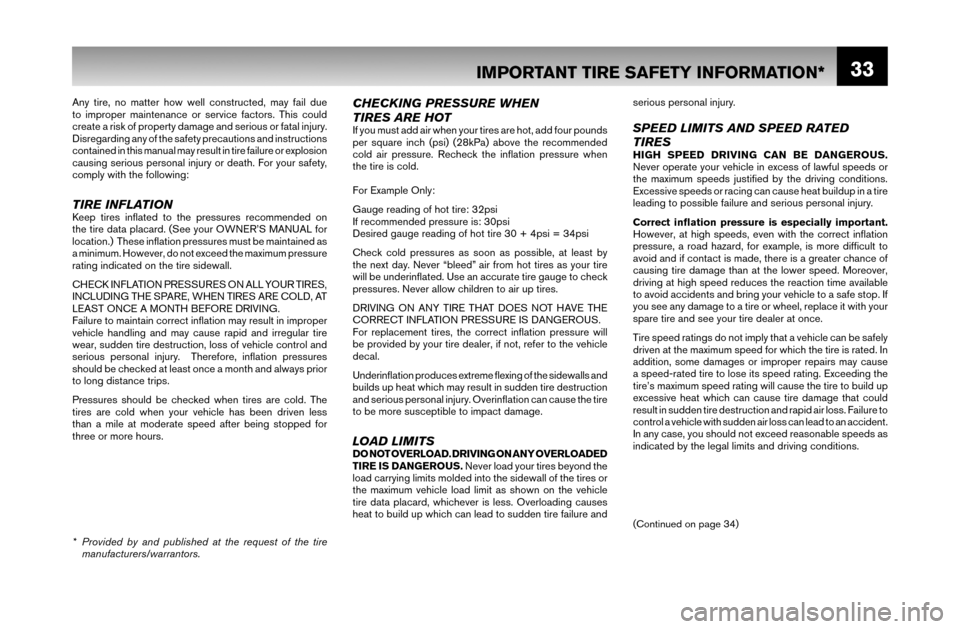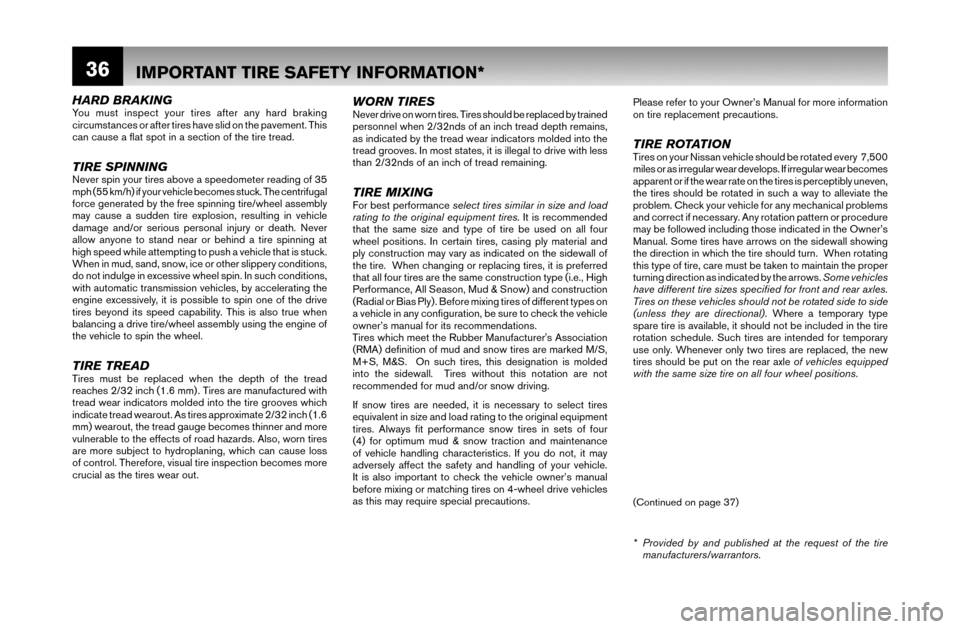2007 NISSAN MURANO four wheel drive
[x] Cancel search: four wheel drivePage 36 of 55

33
Any tire, no matter how well constructed, may fail due
to improper maintenance or service factors. This could
create a risk of property damage and serious or fatal injury.
Disregarding any of the safety precautions and instructions
contained in this manual may result in tire failure or explosion
causing serious personal injury or death. For your safety,
comply with the following:
TIRE INFLATIONKeep tires infl ated to the pressures recommended on
the tire data placard. (See your OWNER’S MANUAL for
location.) These infl ation pressures must be maintained as
a minimum. However, do not exceed the maximum pressure
rating indicated on the tire sidewall.
CHECK INFLATION PRESSURES ON ALL YOUR TIRES,
INCLUDING THE SPARE, WHEN TIRES ARE COLD, AT
LEAST ONCE A MONTH BEFORE DRIVING.
Failure to maintain correct infl ation may result in improper
vehicle handling and may cause rapid and irregular tire
wear, sudden tire destruction, loss of vehicle control and
serious personal injury. Therefore, infl ation pressures
should be checked at least once a month and always prior
to long distance trips.
Pressures should be checked when tires are cold. The
tires are cold when your vehicle has been driven less
than a mile at moderate speed after being stopped for
three or more hours.
CHECKING PRESSURE WHEN
TIRES ARE HOT
If you must add air when your tires are hot, add four pounds
per square inch (psi) (28kPa) above the recommended
cold air pressure. Recheck the infl ation pressure when
the tire is cold.
For Example Only:
Gauge reading of hot tire: 32psi
If recommended pressure is: 30psi
Desired gauge reading of hot tire 30 + 4psi = 34psi
Check cold pressures as soon as possible, at least by
the next day. Never “bleed” air from hot tires as your tire
will be underinfl ated. Use an accurate tire gauge to check
pressures. Never allow children to air up tires.
DRIVING ON ANY TIRE THAT DOES NOT HAVE THE
CORRECT INFLATION PRESSURE IS DANGEROUS.
For replacement tires, the correct infl ation pressure will
be provided by your tire dealer, if not, refer to the vehicle
decal.
Underinfl ation produces extreme fl exing of the sidewalls and
builds up heat which may result in sudden tire destruction
and serious personal injury. Overinfl ation can cause the tire
to be more susceptible to impact damage.
LOAD LIMITSDO NOT OVERLOAD. DRIVING ON ANY OVERLOADED
TIRE IS DANGEROUS. Never load your tires beyond the
load carrying limits molded into the sidewall of the tires or
the maximum vehicle load limit as shown on the vehicle
tire data placard, whichever is less. Overloading causes
heat to build up which can lead to sudden tire failure and serious personal injury.
SPEED LIMITS AND SPEED RATED
TIRES
HIGH SPEED DRIVING CAN BE DANGEROUS.
Never operate your vehicle in excess of lawful speeds or
the maximum speeds justifi ed by the driving conditions.
Excessive speeds or racing can cause heat buildup in a tire
leading to possible failure and serious personal injury.
Correct infl ation pressure is especially important.
However, at high speeds, even with the correct infl ation
pressure, a road hazard, for example, is more diffi cult to
avoid and if contact is made, there is a greater chance of
causing tire damage than at the lower speed. Moreover,
driving at high speed reduces the reaction time available
to avoid accidents and bring your vehicle to a safe stop. If
you see any damage to a tire or wheel, replace it with your
spare tire and see your tire dealer at once.
Tire speed ratings do not imply that a vehicle can be safely
driven at the maximum speed for which the tire is rated. In
addition, some damages or improper repairs may cause
a speed-rated tire to lose its speed rating. Exceeding the
tire’s maximum speed rating will cause the tire to build up
excessive heat which can cause tire damage that could
result in sudden tire destruction and rapid air loss. Failure to
control a vehicle with sudden air loss can lead to an accident.
In any case, you should not exceed reasonable speeds as
indicated by the legal limits and driving conditions.
* Provided by and published at the request of the tire
manufacturers/warrantors.
IMPORTANT TIRE SAFETY INFORMATION*
(Continued on page 34)
57052 Booklet text pages.indd 3357052 Booklet text pages.indd 338/30/06 3:34:25 PM8/30/06 3:34:25 PM
Page 39 of 55

36
HARD BRAKINGYou must inspect your tires after any hard braking
circumstances or after tires have slid on the pavement. This
can cause a fl at spot in a section of the tire tread.
TIRE SPINNINGNever spin your tires above a speedometer reading of 35
mph (55 km/h) if your vehicle becomes stuck. The centrifugal
force generated by the free spinning tire/wheel assembly
may cause a sudden tire explosion, resulting in vehicle
damage and/or serious personal injury or death. Never
allow anyone to stand near or behind a tire spinning at
high speed while attempting to push a vehicle that is stuck.
When in mud, sand, snow, ice or other slippery conditions,
do not indulge in excessive wheel spin. In such conditions,
with automatic transmission vehicles, by accelerating the
engine excessively, it is possible to spin one of the drive
tires beyond its speed capability. This is also true when
balancing a drive tire/wheel assembly using the engine of
the vehicle to spin the wheel.
TIRE TREADTires must be replaced when the depth of the tread
reaches 2/32 inch (1.6 mm) . Tires are manufactured with
tread wear indicators molded into the tire grooves which
indicate tread wearout. As tires approximate 2/32 inch (1.6
mm) wearout, the tread gauge becomes thinner and more
vulnerable to the effects of road hazards. Also, worn tires
are more subject to hydroplaning, which can cause loss
of control. Therefore, visual tire inspection becomes more
crucial as the tires wear out.
WORN TIRESNever drive on worn tires. Tires should be replaced by trained
personnel when 2/32nds of an inch tread depth remains,
as indicated by the tread wear indicators molded into the
tread grooves. In most states, it is illegal to drive with less
than 2/32nds of an inch of tread remaining.
TIRE MIXINGFor best performance select tires similar in size and load
rating to the original equipment tires. It is recommended
that the same size and type of tire be used on all four
wheel positions. In certain tires, casing ply material and
ply construction may vary as indicated on the sidewall of
the tire. When changing or replacing tires, it is preferred
that all four tires are the same construction type (i.e., High
Performance, All Season, Mud & Snow) and construction
(Radial or Bias Ply) . Before mixing tires of different types on
a vehicle in any confi guration, be sure to check the vehicle
owner’s manual for its recommendations.
Tires which meet the Rubber Manufacturer's Association
(RMA) defi nition of mud and snow tires are marked M/S,
M+S, M&S. On such tires, this designation is molded
into the sidewall. Tires without this notation are not
recommended for mud and/or snow driving.
If snow tires are needed, it is necessary to select tires
equivalent in size and load rating to the original equipment
tires. Always fi t performance snow tires in sets of four
(4) for optimum mud & snow traction and maintenance
of vehicle handling characteristics. If you do not, it may
adversely affect the safety and handling of your vehicle.
It is also important to check the vehicle owner’s manual
before mixing or matching tires on 4-wheel drive vehicles
as this may require special precautions.Please refer to your Owner’s Manual for more information
on tire replacement precautions.
TIRE ROTATIONTires on your Nissan vehicle should be rotated every 7,500
miles or as irregular wear develops. If irregular wear becomes
apparent or if the wear rate on the tires is perceptibly uneven,
the tires should be rotated in such a way to alleviate the
problem. Check your vehicle for any mechanical problems
and correct if necessary. Any rotation pattern or procedure
may be followed including those indicated in the Owner’s
Manual. Some tires have arrows on the sidewall showing
the direction in which the tire should turn. When rotating
this type of tire, care must be taken to maintain the proper
turning direction as indicated by the arrows. Some vehicles
have different tire sizes specifi ed for front and rear axles.
Tires on these vehicles should not be rotated side to side
(unless they are directional) . Where a temporary type
spare tire is available, it should not be included in the tire
rotation schedule. Such tires are intended for temporary
use only. Whenever only two tires are replaced, the new
tires should be put on the rear axle of vehicles equipped
with the same size tire on all four wheel positions.
* Provided by and published at the request of the tire
manufacturers/warrantors.
IMPORTANT TIRE SAFETY INFORMATION*
(Continued on page 37)
57052 Booklet text pages.indd 3657052 Booklet text pages.indd 368/30/06 3:34:27 PM8/30/06 3:34:27 PM